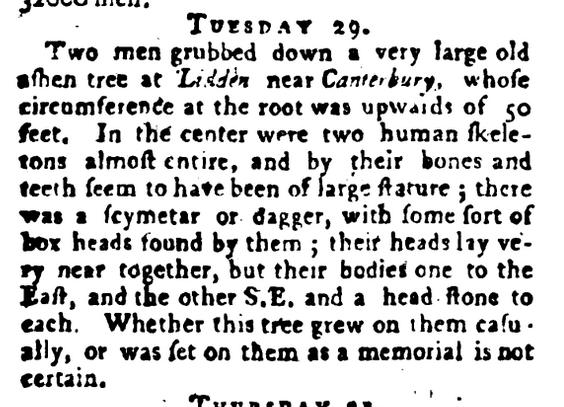Bodies in Elm, 1760? May 6, 2017
Author: Beach Combing | in : Modern , trackbackBeach has recently been searching for records of bodies within trees. There is a lot ill-informed nonsense about such tree burials (in a living tree) as being part of a British magical tradition. Here is one quoted reference from the Gentleman’s Magazine, 30 (1760), pp. 346. The problem is that the text does not live up to its promise.
Two men grubbed down a very large old ashen tree at Lidden near Canterbury, whose circumference at the root was upwards of 50 feet. In the center [sic] were two human skeletons almost entire, and by their bones and teeth seem to have been of large stature; there was a scymetar or dagger, with some sort of box heads found by them; their heads lay very near together, but their bodies one to the East, and the other S.E. and a head stone to each. Whether this tree grew on them casually, or was set on them as a memorial is not certain.
Surely the only way to read this is that as the tree was brought out of the ground two bodies were discovered in the roots of the tree, not in the trunk. The bodies were lying down for one; each had a headstone; the tree grew on them… Beach has published and enjoyed a couple of bodies in trees stories here in his time and there is also the deliriously mad Bella in the Wych Elm tale. Can anyone add any others: drbeachcombing at yahoo dot com.
Note that this sounds like a medieval burial: early medieval burials would not typically have ‘head stones’. But then burial with a dagger would not be very medieval. Perhaps an Anglo-Saxon burial of some kind? Beach’s memory is that burials were more common in Kent than cremations. Possibly the headstone was just all a misunderstanding?
Bruce T, 31 Mar 2017: I live in a little section of valley, about 16 miles long that runs through mile wide river bottoms. For some reason it seems to have been the equivalent of the Vatican for the Adena Culture, predecessors to the following much more well known and publicized Hopewell Culture. Up until the invention of the bulldozer there were hundreds of mounds around, they were mostly razed to make way for industrial development in the period just before, between, and after the two World Wars. As the Adena faded away at roughly 400 C.E. by the time the first Europeans arrived there were huge trees on the mounds. I’ve read more than one account of bodies coming up with the roots when trees on them would go down in storms. A graveyard many of my relatives have been buried in has a smallish Adena era mound in the middle of it with stone slabs on top to support a flagpole. There was a tree there until late 1800s. It went down and there was what was left of a skeleton partially stuck in the roots. Locals took the bones and whatever they found in the mound home and the slabs were placed and the first flagpole erected. It’s on ridge that overlooks the valley for miles. Ironically a number of families had their relatives planted on the flanks of the mound after the tree fell. In a town close by there’s a small family graveyard that is on and around a similar sized mound. It has a large maple growing out of the top of it. If it that tree ever gets uprooted, all sorts of bodies will pop up. It sits on a narrow ridge above where the main groups of mounds were and has a similar commanding view of the countryside in the opposite direction. I guess the settlers figured why waste perfectly good burial mounds? In New Guinea, some tribes put the dried smoked corpses of their dead in crevices in large trees. There’s a treasure chest of tree bodies just waiting for enterprising man like yourself to open it. If you locate Micheal Rockefeller’s shriveled corpse, send it to the Rockefeller Foundation to collect the large, outstanding reward for his remains.



